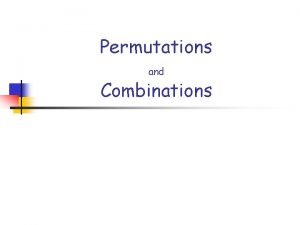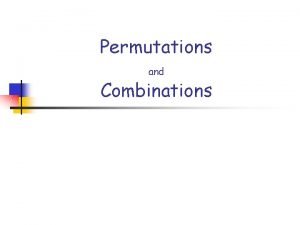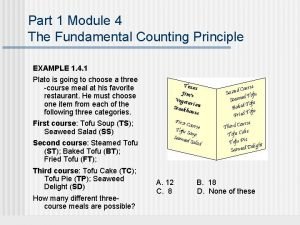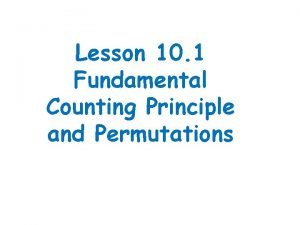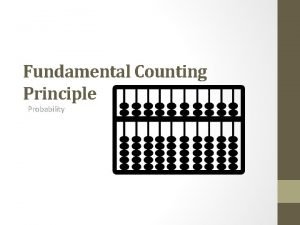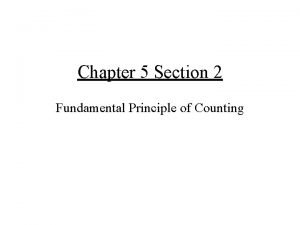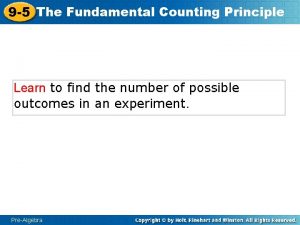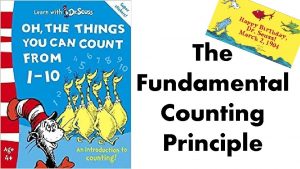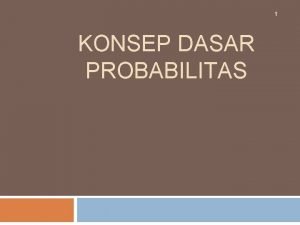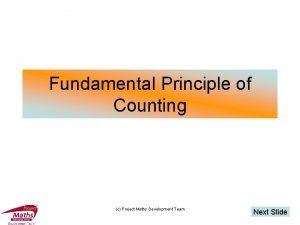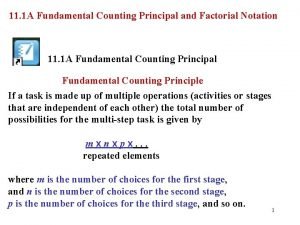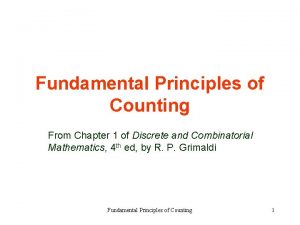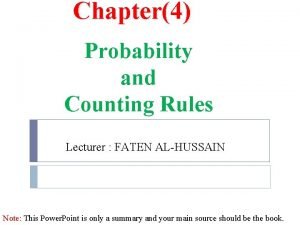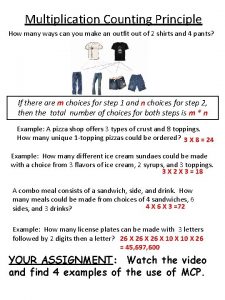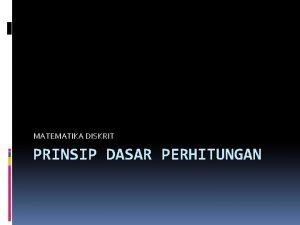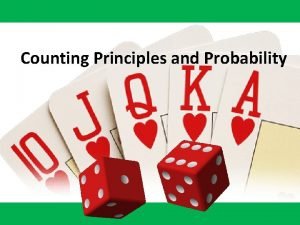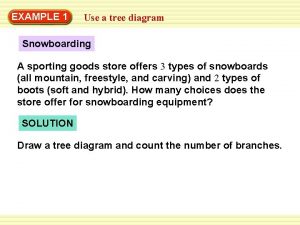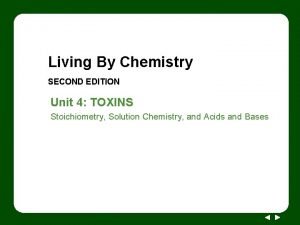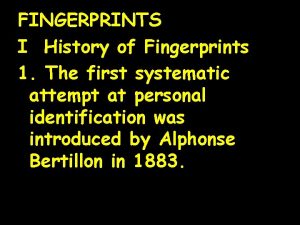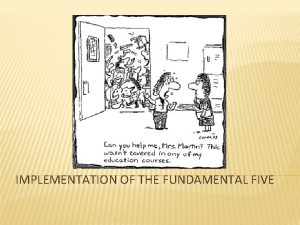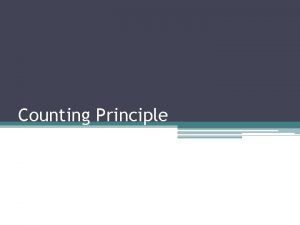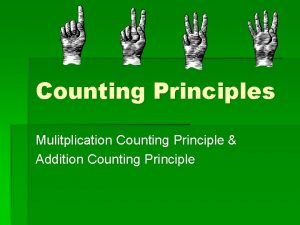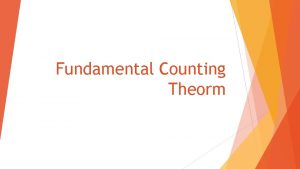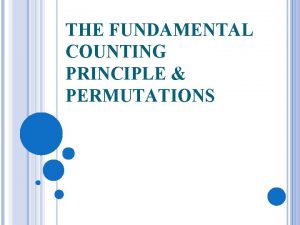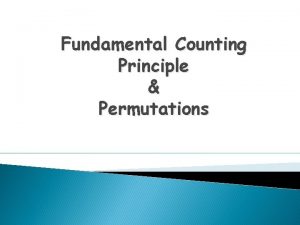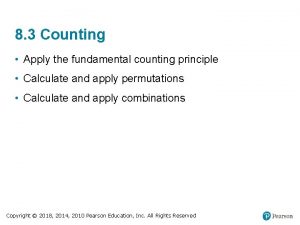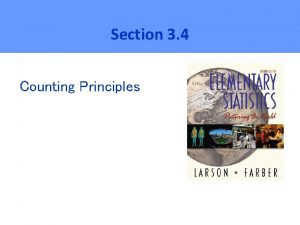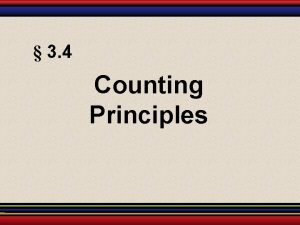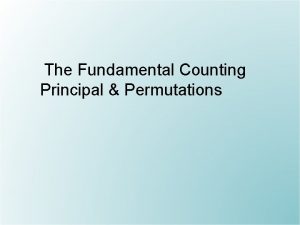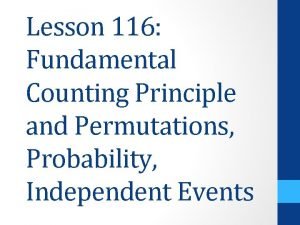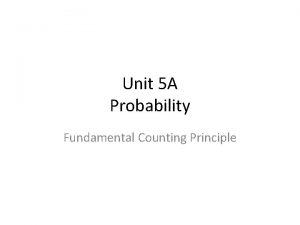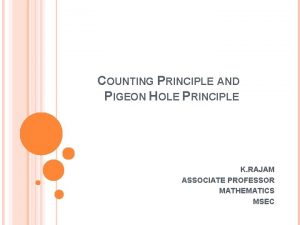FUNDAMENTAL COUNTING PRINCIPLE Lesson 9 5 Fundamental Counting

































- Slides: 33

FUNDAMENTAL COUNTING PRINCIPLE Lesson 9 -5

Fundamental Counting Principle If event M has m possible outcomes and even N has n possible outcomes, then event M followed by event N has m x n possible outcomes. You can use multiplication instead of making a tree diagram to find the number of possible outcomes in a sample space. This is called the Fundamental Counting Principle.

Example 1 Find the total number of outcomes when a coin is tossed and a number cube is rolled. A coin has 2 possible outcomes and a die has 6 possible outcomes. Multiple the possible outcomes together. There are 42 possible outcomes.

Got it? 1 Find the total number of outcomes when choosing from bike helmets that come in three colors and two styles. Draw a tree diagram if needed.

Example 2

Example 3

Got it? 2 & 3 Two dice are rolled. What is the probability that the sum of the numbers on the cube is 12? How likely is it that the sum would be 12?

Example 4

Got it? 4 Two spinners are spun. What is the probability that the product of two numbers that is spun is 12? How likely is that the product would be 12?

Lesson 9 - 5 Homework C = #1 – 4, 6 – 7, 11, 12 A = #5, 8, 9

PERMUTATIONS Lesson 9 -6

Permutations 1. An arrangement, or listing, of objects 2. Order matters Example: Blue, Red, Green ≠ Red, Green, Blue Use the Probability Multiplication Rule to find the number of permutations.

Example 1 Julia is scheduling her first three classes. Her choices are math, science, and language arts. Find the number of different ways Julia can schedule her first three classes.

Example 2 An ice cream shop has 31 flavors. Carlos wants to buy a three-scoop cone with three different flavors. How many cones could he buy if the order of flavors are important? 31 • 30 • 29 = 26, 970 He could buy 26, 970 different ice cream cones.

Got it? 1 & 2 a. In how many ways can the starting six players of a volleyball team stand in a row for a picture? b. In a race with 7 runners, in how many ways can the runners end up in first, second, and third?

Permutations The symbol P(31, 3) represents the number of permutations of 31 things taken 3 at a time.

Example 3 Find P(8, 3) = 8 • 7 • 6 = 336

Got it? 3 a. Find P(12, 2) b. Find P(4, 4) c. Find P(10, 5)

Example 4

Example 5

Got it? 4 & 5 Two different letters are randomly selected from the letters in the word MATH. What is the probability that the first letter selected is “M” and the second letter is “H”?

Lesson 9 - 6 Homework C = #1 – 7, 10, 13 A = #8, 9, 11 or 12

INDEPENDENT AND DEPENDENT EVENTS Lesson 9 -7

Independent Events is when one event does not affect another event.

Key Concept: We will continue to use tree diagrams to show sample space.

Example 1 One letter tile is selected and the spinner is spun. What is the probability that both will be a vowel? Make a tree diagram

Example 1 One letter tile is selected and the spinner is spun. What is the probability that both will be a vowel? Use Multiplication

Example 2

Got it? 2 A game requires players to roll two dice to move their game piece. The faces of the cube are labeled 1 through 6. What is the probability of rolling a 2 or 4 on the first number and then rolling a five on the second one?

Probability of Dependent Events If the outcome of one event affects another event, the events are dependent.

Example 3

Got it? There are 4 oranges, 7 bananas, and 5 apples in a fruit basket. a. Find P(two bananas) b. Find P(orange then apple)

Lesson 9 - 7 Homework C = #1 – 10, 13 A = #11, 12, 15
 Fundamental counting principle vs permutation
Fundamental counting principle vs permutation Fundamental counting principle formula
Fundamental counting principle formula Fundamental principle of counting examples
Fundamental principle of counting examples Permutations
Permutations Tree diagram
Tree diagram Counting principle definition
Counting principle definition Example of fundamental counting principle
Example of fundamental counting principle Fundamental counting principle
Fundamental counting principle Kotak 1 berisi 2 bola merah dan 3 bola putih
Kotak 1 berisi 2 bola merah dan 3 bola putih What is the fundamental principle of counting
What is the fundamental principle of counting Fundamental
Fundamental Fundamental counting principle and factorial notation
Fundamental counting principle and factorial notation Ncr formula
Ncr formula Fundamental principles of counting
Fundamental principles of counting Probability rules
Probability rules Multiplication counting principle
Multiplication counting principle Prinsip penjumlahan
Prinsip penjumlahan A counting principle that order doesn’t matter?
A counting principle that order doesn’t matter? Counting principle examples
Counting principle examples Analisis kombinatorial
Analisis kombinatorial Basic counting principle
Basic counting principle Lesson 75 make it count counting by weighing
Lesson 75 make it count counting by weighing 3 principle of fingerprint
3 principle of fingerprint Two focal points of fingerprint
Two focal points of fingerprint What is the second fundamental principle of fingerprints
What is the second fundamental principle of fingerprints Appointment clock buddies
Appointment clock buddies Lesson outline lesson 3 describing circuits answers
Lesson outline lesson 3 describing circuits answers Lesson outline lesson 3 mountain building answers
Lesson outline lesson 3 mountain building answers Lesson outline lesson 2 aquatic ecosystems answer key
Lesson outline lesson 2 aquatic ecosystems answer key Micro teaching lesson plan format
Micro teaching lesson plan format Ihi l 101
Ihi l 101 Lesson plan on a gift of chappals
Lesson plan on a gift of chappals Chapter 1 lesson 1 your total health
Chapter 1 lesson 1 your total health Lesson outline lesson 3 answer key
Lesson outline lesson 3 answer key
